It is often said that a customer is king. Have you ever wondered why? A customer, consumer, client or end user, whatever you may call him, is someone for whom a business is established. What would a furniture manufacturer do, if nobody is going to buy his tables, chairs and sofa? Customers are at the heart of every decision that a business, be it online or offline, takes. From making easy-to-use smartphone applications to providing after sales services, everything is for the customer and his satisfaction.
A question comes to my mind here. Yes, the companies provide the consumers everything that they need, but how is that possible?
How do they know what the consumer actually wants?
How are they able to know what lies in the minds of the consumers?
How can they know for certain that a consumer would want the product they are planning to provide?
Companies do not just start providing a service without knowing where the consumers stand. They must have some data about the consumers and their preferences guiding them. Yes, they do and they acquire it through a software. The software known as the Consumer Data Platform or CDP allows the businesses to know about their target consumers’ profiles and work their products and services around it.
If you are reading this article, you must have come across the term CDP a lot, you might even have some plans in the works to effectively implement it. Let me tell you that you have landed in the right place. I am going to enrich you with the concept of CDP and all its paraphernalia and marvels. Let us start with the thing that is at the core of CDP.
Consumer Data and Its Importance
Like we have already discussed, customers are the backbone of a business. They are the ones that have the ability to make a business successful. So, every single piece of information that involves a customer becomes important because it gives insights to a business to plan its future endeavours. And these insights refer to customer data.
Customer data is often categorised by businesses into;
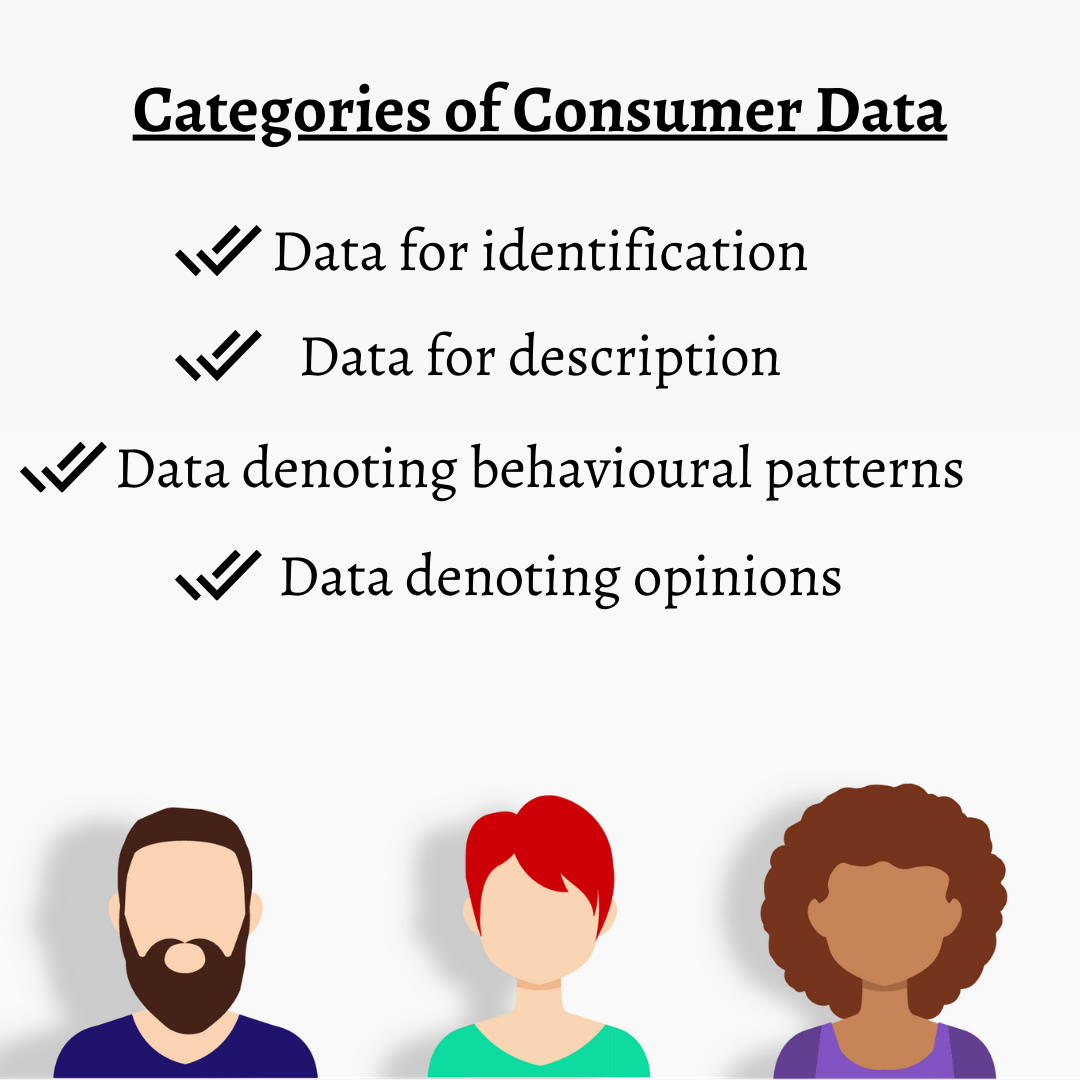
Data for identification
This includes all the information to make identification of the consumer easy. From his name, age and gender to his address and contact information; from the consumer’s professional titles to his social media and bank accounts; the data covers each and every medium to identify the consumer.
Data for description
The descriptive data revolves around the social aspects of the consumer’s life. Both his professional and personal lives are made known to the businesses. Whether a consumer is a clerk or the VP of a company, whether he is married or has children or pets, whether he owns a vehicle or a home or both and finally whether he likes sports or fashion; all these are answered in the data for description.
Data denoting behavioural patterns
It is important to know how active a consumer actually is. What this means is how often does a consumer make purchases. His responses to emails and his online activities including social media are part of this information as well. The higher the engagement, the higher is the chance of a consumer making a purchase.
Data denoting opinions
This is related to the consumer’s personal preferences, basically his likes and interests. A consumer could want a pink glass vase and he could ask his friend to tell him where to shop, his friend to recommend your business because he saw a Facebook post about it. Every piece of information in this scenario is part of the opinionated data or qualitative data, if you think that has a better ring to it. Learn how customer data platforms support personalisation to know more.
All of these categories are important for all kinds of businesses to excel at the services they want to provide. It gives them a direction to move in. However, how do they get it? Read on to find out.
Defining Consumer Data Platform
Now that you know what consumer data actually is, let us delve into the way of retrieving it from the consumers and that is a consumer data platform aka CDP.
A Customer Data Platform is a software that is equipped to gather every piece of information from the consumers that could be useful to the business. It does so through multiple sources, first party, second party and third party, making a holistic profile of the consumer and his needs. The best part is that CDP provides all the data as a unified record of the consumer for all its touchpoints to a business.
It’s official definition as per the CDP Institute explains it as “a software that creates a persistent, unified customer database that is accessible to other parties.
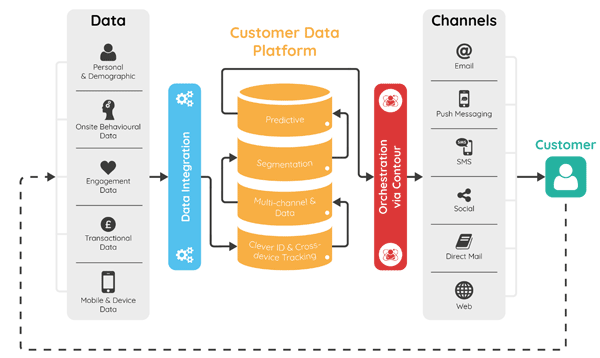
CDP is also competent to merge the latest data with the pre-existing one to create a bigger and clearer picture of the consumer profiles. This helps the people-based marketers in creating products that are exactly what a consumer wants. With CDP the consumer is never an afterthought, he is always at the centre of every decision and makes his experience with the business all the more enjoyable.
Understanding the Need for CDP
Consumer data has always been quite integral to businesses, so the businesses had found ways to collect it, although none of them were as proficient as CDP. You can only imagine how well manual records would have performed in terms of proficiency.
It was the 90s that brought along Consumer Relations Management that allows companies to manage their touchpoints with the present and the future customers. Despite them being better than manual records, they had drawbacks that made curating customer profiles difficult.
The next decade was all about Data Management Platforms or DMPs. It did not use first party data, rather worked with second and third party data. Its primary aim was to cater for advertising campaigns, both planning and executing them. Building customer profiles was not something that was a major concern back in the 2000s, until the 2010s rolled around.
So, in the 2010s, Customer Data Platform was introduced and the consumer data was never the same. It revolutionised the way consumer data was seen and collected. CDP brought along an entire CDP industry within four years of its existence, when even the tag management and web analytics providers started changing their code to accommodate CDP in their solutions. The CDP industry grew quite quickly and for good reason, the alternatives were lacklustre compared to the real gem here and marketers all over the word understood it.
After knowing CDP’s history and popularity, let us understand its attributes that made it happen. CDP had multitudinous benefits that have aided in its success and here they are.
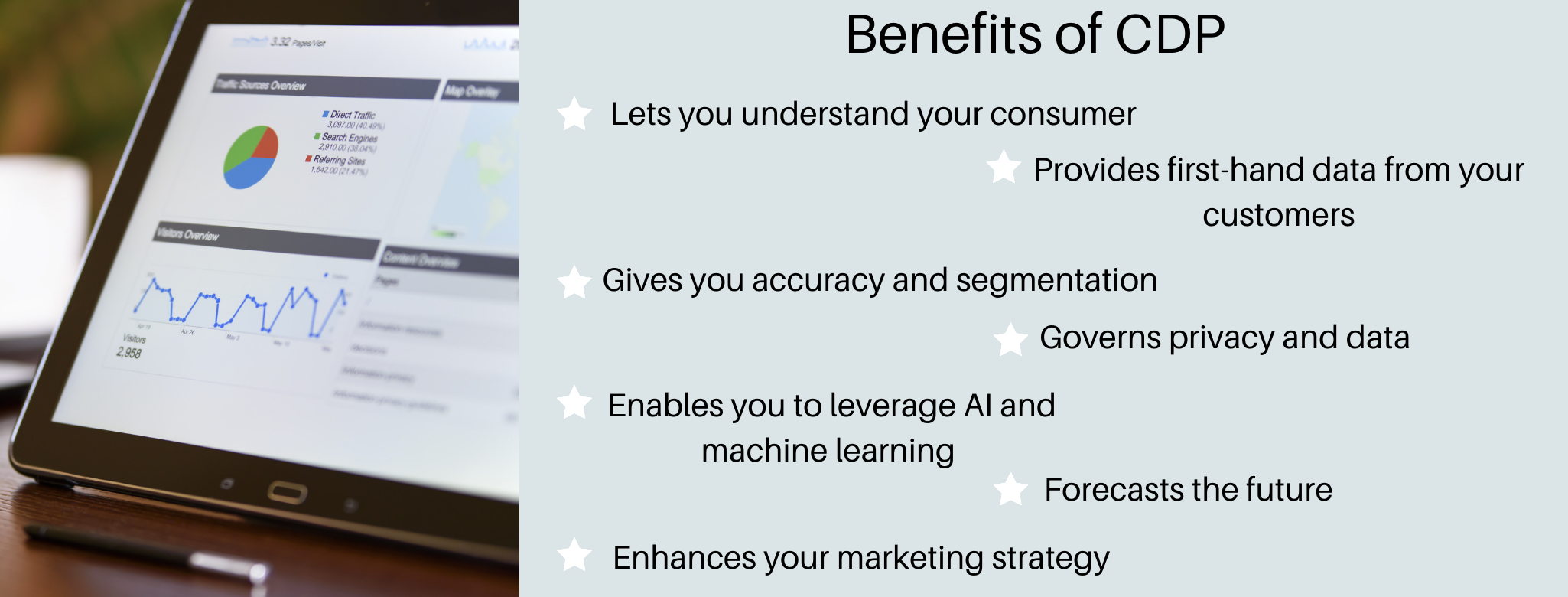
Lets you understand your consumer
The foremost feature cum advantage of a CDP is the fact that it allows a business to come in close contact with its customers leading to better understanding of their mindset. Of course, this close connection is in the form of the customer data. CDP collects data from various platforms, leaving nothing behind as an unrecognised form of data. What this constitutes for is vigorous reporting and open communication. Consequently, business owners and strategists are able to create sound consumer profiles indicating their behaviour and patterns to further the interests of the business.
Provides first-hand data from your customers
Like I just mentioned, CDPs gather data from a lot of different sources, one of these is the data collected directly from the consumer himself, rather than second or third parties. The information that a consumer gives you directly is often the most reliant and helpful for businesses. It gives them keen insights into what a consumer thinks and expects from a product or service.
For instance, many ecommerce websites conduct surveys in which you must have partaken once or twice. Because the consumer is on the website to gain something out of it, he is bound to give a more honest answer and help the website in improving its user experience. The direct line to the consumer’s thought process is a great advantage to have.
Gives you accuracy and segmentation
CDP is not just the gathering of information, it involves gathering the information in a well-organised manner. As a result, there is a high degree of accuracy in the data which means better segmentation of the gigantic proportions of consumer data. With proper segmentation of data, there is a better chance of consumer engagement using the right kind of information for the right kind of marketing projects.
Governs privacy and data
Privacy invasion is a serious offence today. When a CDP collects information, be it the name of the consumer or his zip code, everything has to be protected. CDPs do just that, it secures the Personally Identifiable Information and only grants access to those who need it. Any data leaks or security breaches are almost impossible with the amount of control a CDP holds over its collected data.
Enables you to leverage AI and machine learning
Collecting consumer data may see, quite easy, when actually it isn’t, at least not all of it. That is why CDPs come equipped with Artificial Intelligence and Machine Learning to make the processing of the influx of data easy. With the merge of AI and ML, the increasing complexity of consumer data is being simplified by CDPs. The generation of smart datasets and their evaluations often provide fruitful recommendations for policy making. As the number of consumers and the proportion of consumer data is only going to multiply, this feature is becoming quite handy.
Forecasts the future
CDP may just collect past information about the consumer, but that does not stop the software to make a play for the future. The predictive models in CDPs give it the power to forecast the future based on the past actions of a consumer. A simple change in the CTAs based on the visitors time on the website can contribute to future sales.
Enhances your marketing strategy
This software can cover the distance between a good marketing strategy and a great one. A sound marketing strategy is supposed to start at product designing and never end. That would mean it has to bounce around a lot of different areas. CDP offers its assistance in making the bouncing less tiresome because it can consolidate data from varying channels and let the marketers get inspiration from it.
Categories of CDP
Now, it is the time to get into the varying types of CDP. There are several, how could it be possible to curtail such a versatile software into one categorisation, right? So, let us get right on it.
Primarily, CDPs are classified into two broad categories with more subdivisions inside them.
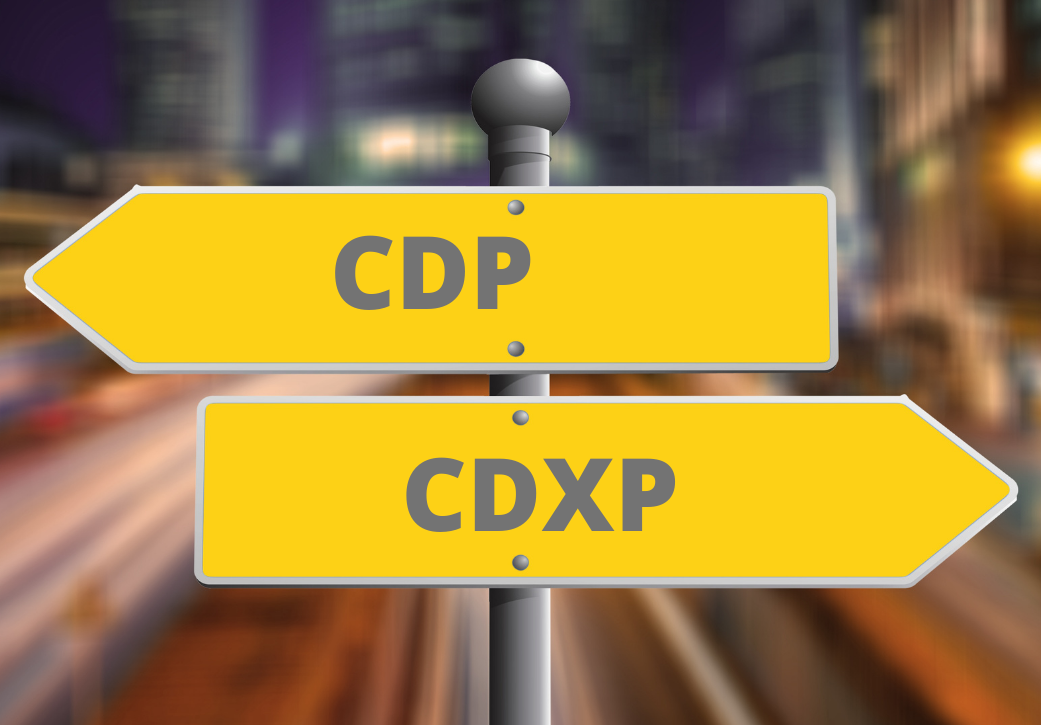
On the basis of Capabilities
As a consumer, you could want a lot of different things from a vendor or you could want one good thing. On the same principle, the first CDP classification differentiates them on the basis of their provisions. Are they providing just consumer data or are they providing some extra benefits as well. Here are the two CDPs that fall under this class.
Conventional CDP
Consumer Data Platform was conceptualised to ingest all the consumer data available to create a concise picture of the consumers, which is CDP terminology is a single customer view.This allows a business to have minute segregations of the audience in separate segments. All of this is done by the conventional CDP, which may also be referred to as standalone CDP.
Now, that is all that falls under the capabilities of this CDP. It cannot go beyond and perform the executions of the campaigns for you. It provides a single product in the form of customer views, take it or leave it. It provides analytical services, but lacks the ability to execute any projects. So, companies lacking the execution skills may have to find a different CDP to get the complete experience.
Consumer Data Experience Platform
The acronym CDXP has been described as the advanced successor of the CDP. It can do all of the things that the conventional kind does, plus some more. And this ‘some more’ is the reason why CDXP is becoming all the rage today. The possession of an experienced cloud makes CDXP more powerful than its predecessor to become a customer-centric marketing platform. A CDXP combines AI-powered marketing automation and real time analytics with UX optimisation to create a CDP that will provide exceptional customer experiences. The fact that it collects regularly used tools in a cohesive interface leads to heightened productivity at work.
CDXP provides an opportunity to interact with the consumers by precisely targeting them, this often leads to a holistic consumer view that eventually helps in building campaigns that are founded on consumer-loyalty. All of this compels me to say that CDXP is the new-age of CDPs that makes you respond to market changes and consumer preferences to gain maximum advantage.
On the basis of Organisational Suitability
Every organisation has some specific needs that it requires to be fulfilled by the CDP vendors. These could be knowing consumer touchpoints, creating their profiles or categorising consumers into a segment:
- If you are only looking for rearranging consumer data by moving it from one point to another without seeking a unified outlook for it, the ‘Rearranging’ CDP is perfect for you. Tag managers are great examples of the same.
- If you own a small online business and want to unify data from different digital channels, then you can opt for the ‘Simplistic’ CDP.
- If you want to segregate your consumers into categories, like new and existing, and are not looking for single customer profiles, then CDPs that excel at activating profiles should be taken up.
- If your focus is to keep track of all the consumer touchpoints in a centralised database and not let silos affect its working, a ‘Cloud’ CDP is calling your name. It has analytics, reporting and customer insights along with machine learning working in its favour.
- If you are looking for experience that can create a persistent database with a single consumer view that is both robust and highly accurate, you should look for an expert, which is scalable, real-time and secure. Providing a comprehensive identity resolution would be no problem for it.
Effective Usage of CDP
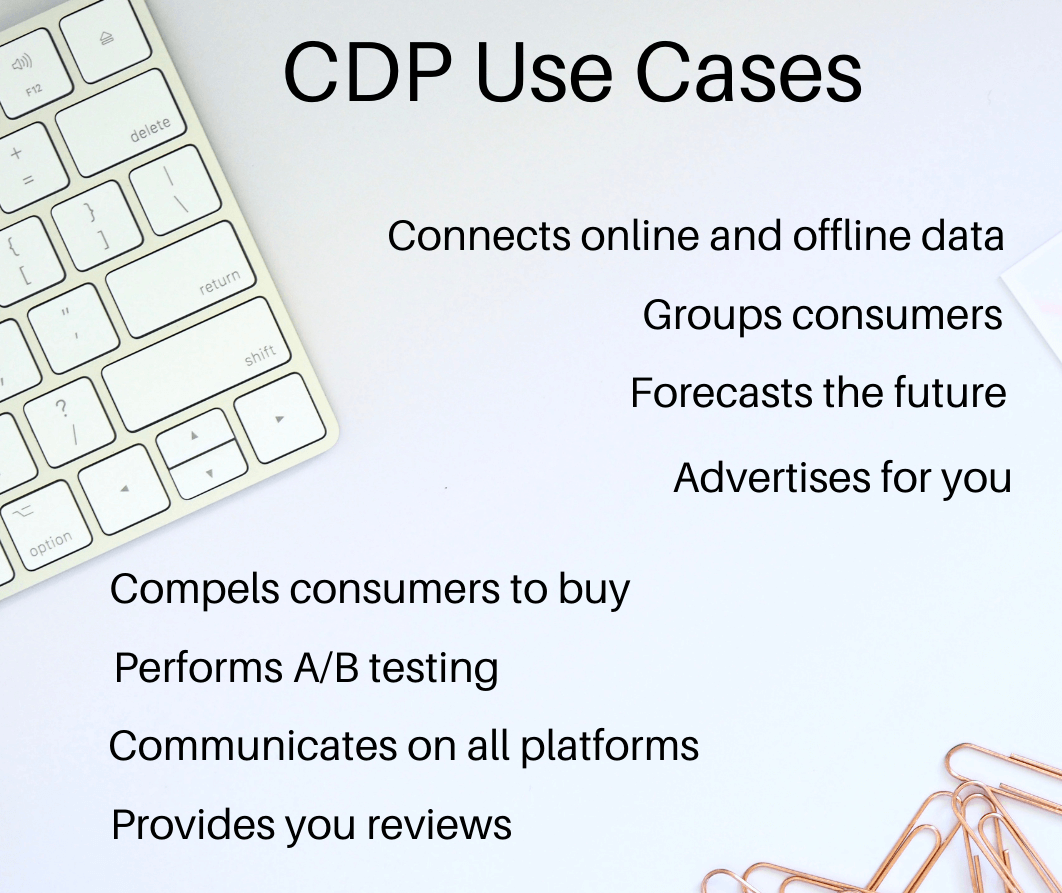
A pivotal area of CDP is its use cases, which basically means what the software will accomplish for you and your business, an end goal of sorts and how to use the CDP to get there. Being clear on the uses of CDP paves the way for any business to gain as much from it as possible. Here I am with a list of goals that should be on your radar before you make the purchase of a CDP, so let’s start.
The online and offline connection
The foremost use case for a CDP has to be creating a tie between the online and offline data of the consumer. If the local store knows what a consumer needs and what his interests are, it is bound to impress the consumers and a sale becomes almost guaranteed.
The consumer grouping
The segmentation of consumers or their grouping is also an important consideration. A CDP must be able to group together customers with similar interests, preferences, income level or even something as their profession to make comparisons easy.
The future forecast
The future forecasts also become quite handy. The likelihood of an item in the wishlist moving to cart and being bought by the consumer is not going to go in vain laong with knowing what the probability is for a consumer to open an email advert and be impressed enough to visit the website. Don’t you agree?
The advertising play
Next comes the actual advertising, CDPs have the ability to trace consumer activities on multiple channels. Why? So that the businesses acn put out similar ads on those channels in order to imbed themselves in the consumers’ minds. Why else do you think you keep seeing the same ads on your Instagram feed, Facebook account and as Google ads?
The compelling urge
Have you ever seen websites urging you to see what's trending? Which pair of shoes will suit the dress you just put in your cart? Or maybe what other products match to the one that you are looking at? And my personal favourite “your empty cart misses you.” CDPS aid website in cooking up all these scenarios for the consumer compelling him to make that purchase. It works on me everytime.
The A/B testing
Websites are all about trial and error and A/B is the way to go. Building two websites or just landing pages slightly different from each other, but equally good, to gauge the reaction of the audience is indeed one of the finer aspects of CDPs.
The ubiquity
Since CDPs deal with consumer data all day every day, they know the communications channels that are preferred by the consumer, it could be one or many. So what happens then? Businesses will bombard the consumer with offers and deals that he just cannot ignore after a point, the added personal touch to it is just a bonus. I recently bought an H&M pants because the website explicitly told me it is the right fit and style for me based off of my previous purchases.
The review channelisation
There are a number of CDPs that will provide you more consumer reviews for your products, services and even user experiences, so that you know where you stand with the consumers. NPS surveys are often the most reliable.
And that is about the extent of what use cases you must know about, although there would be more so many more, but these have to be in an optimal CDP.
Choosing the Right CDP
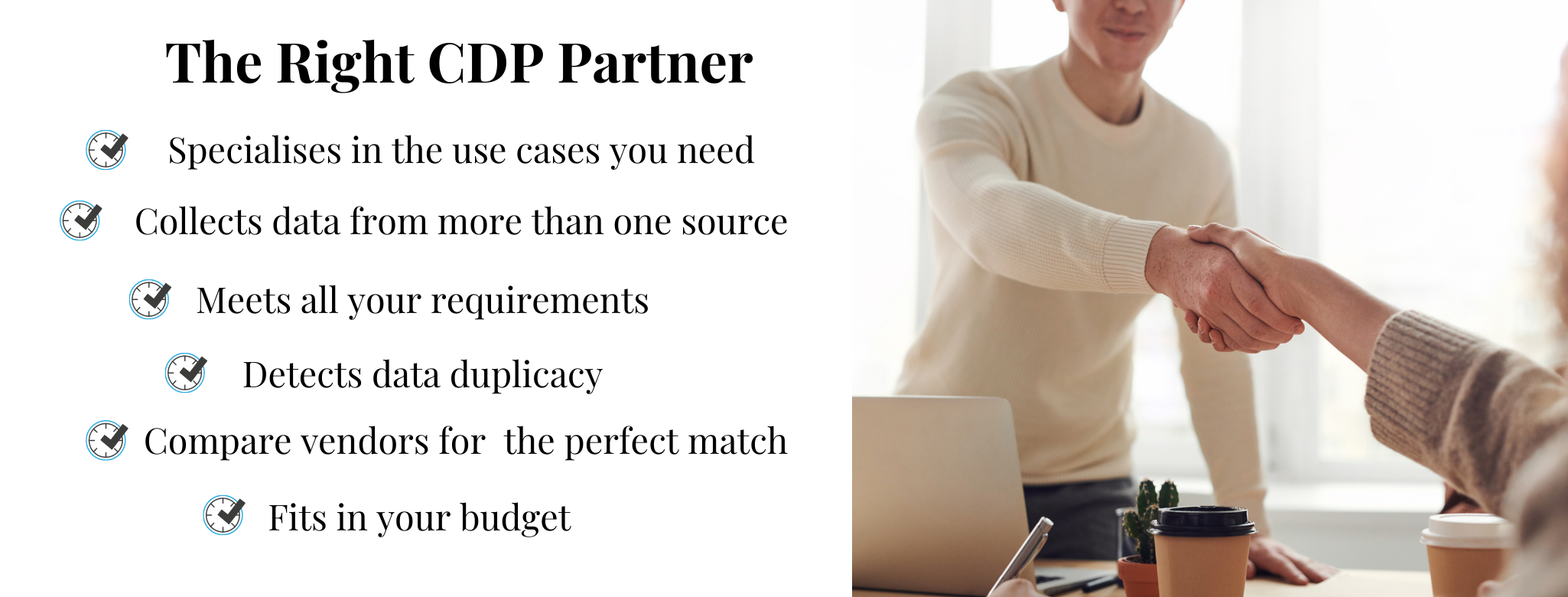
A CDP can be a huge undertaking by a business that can have a number of effects on its operations, hopeful good, possibly bad. So, choosing the right CDP to partner with has to be done with the utmost care and dedication.
Here is a list of questions that you need to ask yourself before taking on the commitment.
What use cases do you need it for?
A CDP can do a world of things for you, but the important question is what do you want it to do for you. CDPs consolidate data for you, so what do you do with the consolidation? The answer to this is the first step in the selection process. You can use a CDP to get a clearer understanding of your target audience, you can use it to prepare an entire ad campaign or you can use it to merge your online data with the offline. Decide and then move forward.
How would it collect the data?
We know a CDP is all about data collection, but how. That is what you find out. Depending on your use cases, the way of gathering can be different. A software that collects data from varying sources, compiles it as one and creates a 360 degree consumer profile for you is the most ideal. Apart from this, segmentation of data based on consumer data based on their preferences, likes and interests is always welcome too.
What are your requirements?
Next comes your requirements, you might think we have discussed it, but we have not. This is not what you would do with the information after it comes but what you want from the process. Asking for an unbreachable security from your CDP is wise, for the same, you can look for an ISO certification.
Does it detect data duplicacy?
Duplicacy of data often makes its assessment cumbersome, so wanting a CDP which detects duplicate data is not unreasonable. Businesses that have multiple sources to gather information from often suffer from duplicacy, so their detection and removal becomes an important part of the CDP journey.
Do compare the vendors?
Now that much of the working is clear, it's time to compare the various CDP vendors. You can’t just choose the first one that pops up. You have to evaluate the experience of the vendor, whether it has some with the level at which your business is at, what is its success rate, how fulfilling an experience does it provide in terms of user case accomplishments; all of these will point towards the right choice.
What is your budget and the ROI?
We’ll come to the financial implications of the CDP at last. Like it is often said, all that shimmers is not gold, so you must not think that the most expensive will only bring you the most results. Rather you need to focus on three things;
How much functionality is it going to offer, especially given the price?
What your budget is and how much you can stretch it?
And finally, which option will provide you with the best results and value for money?
Check out the complete checklist on how to know if a CDP is a right fit for your organisation, how to choose the right CDP and how to finally implement CDP to know more.
CDP vs CRM vs DMP
By this point, you almost have all the facts that you need to know about a Customer Data Platform. You know everything about its working and its presence in the market. Still it is important to know how it is different from its predecessors who are still its competitors on some level. There aren’t many, just two CRM or Customer Relationship Management and DMP or Data Management Platform.
If you look at what these three software do in a basic level you wouldn’t find much of a difference. CDP, CRM and DMP collect consumer data and provide it to businesses to further their understanding of the consumers. However, the way they do it is colossally different.
| CDP | CRM | DMP |
| CDPs focus on marketing. | CRMs prime concern is sales. | DMPs are more attentive towards advertising. |
| CDPs collect data from a variety of channels, first parties along with second and third parties. | CRMs only gather data from an actual contact of the consumer with the business, the first party data. | With DMPs, the data is collected from anonymous sources, like cookies. Being only third party data. The identity of a consumer is never known. |
| These focus on customers, both existing and potential as well as visitors. | These only focus on existing customers. | The focus is on everyone, just anonymously. |
| A consumer profile tracks his journey throughout the lifetime. | CRMs are not equipped for tracking the consumer’s entire journey with the organisation. | DMPs are short sighted, adhering data only for the purpose of an ad campaign or look-alike audience. There is usually a 90 day window on the usefulness of the data. |
| The data in a CDP is real-time, meaning it would change as soon as the consumers change their preferences. | The chances of the data being antiquated are worrisome in a CRM. | The data is real-time in DMPs as well. Owing to its short lifespan, it cannot become obsolete. |
| It has the ability to track both online and offline consumer data. | Offline data is off-limits with a CRM. | DMPs also collect data from online and offline sources. |
| With CDP, data mishandling is almost impossible. | CRMs store data that is manually entered, that too with individual entries. So, mismanagement becomes a possibility. | Data mishandling is not a concern with the use of DMPs. |
Now, do you see? A CDP is like an advanced offspring to a CRM and DMP, with more features and abilities than both of them combined. You can also check our detailed comparison between CDP and CRM based on the use cases to make better business decisions.
Future of CDP
As an end to our guide to CDP, I couldn’t think of a more befitting note than what its future may hold. Let me tell you that for CDP, the future is as bright as the sun on a hot summer day. It is said to experience the highest growth rate any industry has ever experienced in the next half decade. Many reports and estimates have surfaced on the internet and a compound annual growth rate is predicted to be anywhere between 16% to 34% by 2025, with a market size possibly as much as 10 billion USD worldwide. If that does not make your jaws drop, I am not sure what will.
I’ll end by saying that consumers are the driving force of the business sector, they are what keep it up and running. With CDPs a business can actually get into the minds of their drivers and win the only race that matters to them; the race to get the highest rewards.
Subscribe
Related Blogs
Ecommerce And Data Analytics: Increase Your Sales
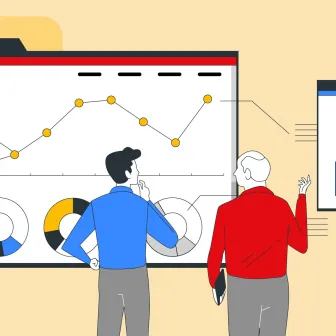
Are you seeking to achieve a greater return on investment while gaining a deeper understanding of ecommerce and data…

"Constant data breaches and scandals have brought new attention to Customer Data Platform (CDP) with the business Martech…
How to successfully implement CDP

For years, marketing executives have gone after an elusive 360-degree view of their customers. Today, the very nature of…




